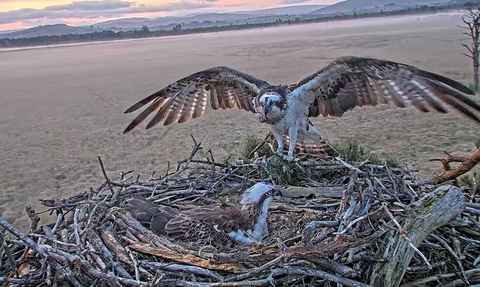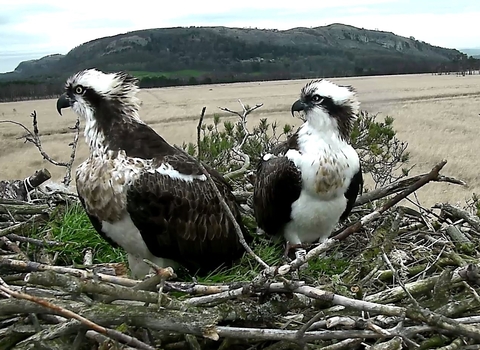
Foulshaw Ospreys FAQs
Here are some of the most frequently asked questions that we receive about the Foulshaw Moss ospreys.
Are ospreys back in the UK?
Ospreys fly back to the UK in spring - normally in late March or early April. The adults return to their breeding sites but juveniles stay in Africa or their wintering ground and normally don’t return to the UK until their second year.
Where is the best place to see ospreys?
There is a breeding pair of ospreys at Cumbria Wildlife Trust’s reserve at Foulshaw Moss.
The male, White YW, and female, Blue 35, have successfully nested at Foulshaw Moss for ten years. They spend the winter apart and then return to their breeding site separately and, normally and amazingly, within a few days of each other.
You can view the ospreys from a viewing platform on the reserve either using your own binoculars or through the on-site telescope. For a close-up view there is a webcam which you can also access remotely on your phone or computer.
When is the best time to see the ospreys?
The adult ospreys return to their nest to breed in the spring, normally during the last week of March or first week in April. They stay to rear their young before the family leaves for their wintering grounds towards the end of August or the beginning of September.
What do we know about the Foulshaw ospreys?
The Foulshaw male, White YW, hatched 16 years ago at Bassenthwaite and the female, Blue 35, hatched 14 years ago at Kielder. They have been successfully nesting at Foulshaw Moss since 2014 raising 27 chicks.
Ospreys are faithful to their nest site and to their mate. They very rarely leave a living partner but, if their mate fails to return from migration, they will often find another partner to make sure that they have the opportunity to pass their genes on to a further generation.
Although, sadly, the survival rate for youngsters is poor (less than 30% survive), adult ospreys can live up to 20 or 25 years. So, hopefully, we will see White YW and Blue 35 at Foulshaw for a few more years.
How many chicks have the Foulshaw ospreys had?
Since the Foulshaw ospreys breeding pair started nesting at Foulshaw Moss Nature Reserve in 2014 they have raised 27 chicks; 13 male and 14 females.
It's fantastic when we get positive news that some of our chicks have survived their first
Blue V3, hatched in 2015, was sighted at Kielder in 2017.
In 2020, Blue N0, hatched in 2017, was filmed inspecting an occupied nest in Montgomeryshire Wildlife Trust Dyfi Reserve.
Blue 462, hatched in 2021, was spotted on the Foulshaw nest webcam in May 2023. She was seen off by her mother, Blue 35!
Why do you ring the young ospreys?
All our chicks are ringed before they fledge the nest. They receive two rings. One is a metal British Trust for Ornithology (BTO) ring which is part of the National Bird Ringing Scheme. This ring contains a unique number to identify the bird as well as contact details so that it can be reported if it’s found.
The other, larger ring is called a Darvic ring (named after the strong plastic material that it’s made of). It’s placed on the other leg and has a background colour with large contrasting letters or numbers on it – hence Blue 35 and White YW.
The Darvic ring can been read through binoculars, telescope or telephoto camera and can help to identify the bird either in flight, visiting a nest or roosting in its wintering grounds.
Both rings are really valuable in helping us to build up knowledge on lifetime reproduction. It means that we can find out whether our birds return to their natal area; identify the origin of new birds (intruders) in the area and build up records on mating partners and brood success rates.
It lets us study how many young birds leave the nest and survive to become adults, as well as how many adults survive the stresses of breeding, migration and severe weather.
Where do the ospreys migrate to?
Satellite tracking over the past few years has been enormously helpful in following ospreys as they migrate between their breeding sites and wintering grounds. At the end of the summer the ospreys that breed in the UK will typically migrate towards southern Spain and Portugal and then onwards to West Africa, although some will stay around the Iberian Peninsula.
We would expect the Foulshaw ospreys to make a similar journey, flying south across western France, Spain and Portugal, where they may remain or continue their journey across the Gibraltar straits to Morocco keeping close to the west coast of Africa to reach their wintering grounds in, possibly, Senegal or The Gambia.
We have received reports of previous Foulshaw ospreys in their wintering grounds. Blue V8, hatched in 2016, was spotted in The Gambia; Blue 5N, hatched in 2018, was also seen in The Gambia and Blue 7N, hatched in 2018, was seen in southern Spain.
Our very own Blue 35 was seen in Spain in 2017, kindly captured on video by osprey enthusiast, Alberto Benito.
Why do ospreys migrate?
Ospreys leave their northern breeding grounds at the end of the summer and before the weather gets too cold. In the northern winter there is a lot less daylight for the birds to fish and as the water gets colder the fish tend to swim deeper, making it more difficult for the ospreys to catch their prey.
In more northern sites, there is also a risk of the rivers and lakes freezing over, making it totally impossible for the ospreys to fish.
How do ospreys navigate?
There is still a lot of mystery about migration. We still do not know exactly how birds like the osprey navigate. We think it could be a combination of visual clues (we know they fly more in good clear weather); genetic instinct, and some form of geomagnetic perception, using the earth’s magnetic field to navigate.
The adult ospreys are faithful to their wintering site just as they are to their nest site so they will return to the same place each year to claim their perch.
Juvenile ospreys generally stay in their wintering grounds for their first two years before they return to their breeding grounds when they will often visit various nesting sites to search for suitable nests and mates. They generally don’t start breeding until they are four or five years old.
Do ospreys overwinter together?
No, they don’t winter in the same place as each other. They do have their own wintering site, which they return to each year, but they spend the winter apart and meet up at their breeding site in the spring.
If your question isn't answered here, please get in touch by emailing us with it, or use #FoulshawOspreys on X and Facebook, and we'll get back to you as soon as we can.

Osprey nest
Watch the osprey family in their nest at Foulshaw Moss Nature Reserve. They're usually at the nest site between March to early September.
